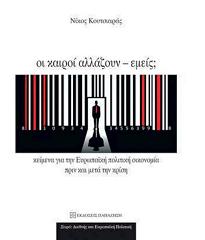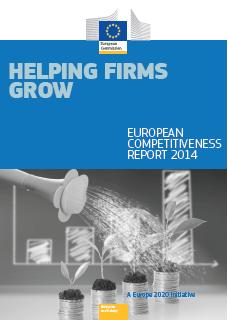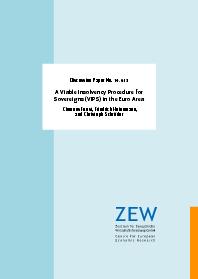Binder, M. & Coad, A. (2014) “Heterogeneity in the Relationship between Unemployment and Subjective Well-Being, A Quantile Approach“, Explorations in Theory and Empirical Analysis, Working Paper No. 808, Levy Economics Institute, Ιούνιος. Unemployment has been robustly shown to strongly decrease subjective well-being (or “happiness”). In the present paper, we use panel quantile regression techniques in order to analyze to what extent the negative impact of unemployment varies along the …Read More
Η Ευρώπη εν μέσω οικονομικής κρίσης – Συνέπειες της νομισματικής ένωσης
Τσούκαλης, Λ. (2014) “Η Ευρώπη εν μέσω οικονομικής κρίσης – Συνέπειες της νομισματικής ένωσης“, Εφημερίδα «Καθημερινή», 14 Σεπτεμβρίου. ΝΙΚΟΣ ΚΟΥΤΣΙΑΡΑΣ: Οι καιροί αλλάζουν – εμείς; Κείμενα για την ευρωπαϊκή πολιτική οικονομία πριν και μετά την κρίση. εκδ. Παπαζήσης, σελ. 338 Στις μεγάλες κρίσεις, πολλά από όσα θεωρούσαμε δεδομένα αλλάζουν, τα θέσφατα δεν ισχύουν πλέον. Πόσοι όμως έχουν την ικανότητα ή το κουράγιο να κοιτάξουν κατάματα τη νέα πραγματικότητα που …Read More
Restoring financial stability with economic growth
Boughton, J. (2014) “Restoring financial stability with economic growth“, VoxEU Organisation, 15 Σεπτεμβρίου. The international financial system is not working fine and reforms of regional and global institutions are much needed. This column discusses some of the transformations that the IMF could implement in order to keep pace with the changes in the world economy. One problem for the credibility of the IMF is the G20 in its current …Read More
Parallels to 1937
Shiller, R. J. (2014) “Parallels to 1937“, Project Syndicate Opinion Page, 11 Σεπτεμβρίου. The depression that followed the stock-market crash of 1929 took a turn for the worse eight years later, and recovery came only with the enormous economic stimulus provided by World War II, a conflict that cost more than 60 million lives. By the time recovery finally arrived, much of Europe and Asia lay in ruins. The …Read More
Monthly Bulletin: September
European Central Bank (2014) Monthly Bulletin: September, ECB–Eurosystem, Σεπτέμβριος. Based on its regular economic and monetary analyses, the Governing Council decided at its meeting on 4 September 2014 to lower the interest rate on the main refinancing operations of the Eurosystem by 10 basis points to 0.05% and the rate on the marginal lending facility by 10 basis points to 0.30%. The rate on the deposit facility was lowered …Read More
European Competitiveness Report 2014
European Commission (2014) European Competitiveness Report 2014, Commission Staff Working Document SWD(2014)6319 final, Σεπτέμβριος. The European Competitiveness Report, published annually since 1997, gives a quantitative assessment of the competitive performance of EU industries. It contributes to evidence-based policy-making by looking at knowledge gaps in industrial policy. Therefore it supports microeconomic decision-making at EU and national levels. The Report uses empirical research to examine EU competitiveness, working across the whole …Read More
A Viable Insolvency Procedure for Sovereigns (VIPS) in the Euro Area
Fuest, C., Heinemann, F. & Schröder, C. (2014) “A Viable Insolvency Procedure for Sovereigns (VIPS) in the Euro Area“, Centre for European Economic Research (ZEW), Discussion Paper No. 14, Αύγουστος. The euro area debt crisis has revealed serious flaws in the institutional setup of the European Monetary Union (EMU) as it had been designed in the late 1990s (Buti and Carnot, 2012; Hodson, 2013). Although the establishment of a …Read More
Why does Italy not grow? – The Italian economy has barely grown since it joined the euro area in 1999
Mody, Α. & Riley, Ε. (2014) “Why does Italy not grow? – The Italian economy has barely grown since it joined the euro area in 1999“, Bruegel Institute, 09 Σεπτεμβρίου. In April this year, the Italian debt-to-GDP ratio was expected to peak by year-end at 135 percent of GDP. That projection assumed a real GDP growth rate of 0.6 percent and inflation of about 0.7 percent. The projected decline …Read More
Facing Reality in the Eurozone
Turner, Α. (2014) “Facing Reality in the Eurozone“, Project Syndicate, 08 Σεπτεμβρίου. European Central Bank President Mario Draghi’s recent speech at the annual gathering of central bankers in Jackson Hole, Wyoming, has excited great interest, but the implication of his remarks is even more startling than many initially recognized. If a eurozone breakup is to be avoided, escaping from continued recession will require increased fiscal deficits financed with ECB money. …Read More
A ‘sovereign subsidy’ – zero risk weights and sovereign risk spillovers
Korte, J. & Steffen, S. (2014) “A ‘sovereign subsidy’ – zero risk weights and sovereign risk spillovers“, VoxEU Organisation, 07 Σεπτεμβρίου. European banking regulation assigns a risk weight of zero to sovereign debt issued by EU member countries, making it an attractive investment for European banks. This column defines a ‘sovereign subsidy’ as a new measure quantifying to what extent banks are undercapitalised due to the zero risk weights. …Read More










